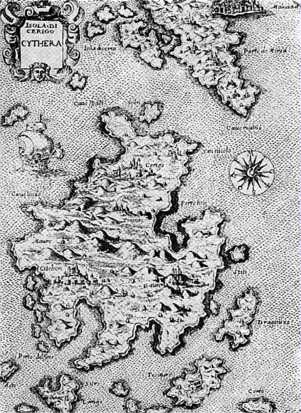
Cy·the·ra (s-thîr, sthr-) also Kí·thi·ra (kth-rä) and Kythera (keye-thear-uh) An island of southern Greece (also known as Cerigo) in the Mediterranean Sea south of the Peloponnesus. Southernmost of the Ionian Islands, it was the chief center for the worship of Aphrodite.The adoration of Aphrodite comes from the East. Phoenicians brought their adoration to Kythera and her first name was Astarti. Her full name is Celestial Aphrodite. The name Celestial connects the Aphrodite with the Phoenicians because the goddess Astarti was the Phoenician queen of the sky. Also for the Greeks, Aphrodite was the daughter of the Uranus so the name Celestial is from that fact. According to the linguists, Aphrodite probably took her name from the froths of the sea where she was born. Froth = aphros (Greek) = Aphrodite. Some people say that Aphrodite’s adoration first came to Kythera from the Assyrians, but Paphsanias says that the Kytherians learned the adoration of the Aphrodite from the Phoenicians. Also Homer calls the Aphrodite "Kytheria." According to Hesiod, Kythera is were Aphrodite was born, whose sanctuary was considered to be the most respectable. In Kythera Aphrodite was adorated as the goddess of pure love and in Cyprus as the goddess of carnal love.
In Greece Aphrodite had many names based on the characteristics attributed to her personality and her origin. Some of them are: "Anadiomeni," "Aphrogeneia," "Anosia," "Assyria," "Asiraia," "Bareia," "Geneteira," "Galinea," "Doritis," "Etaira," "Erytraia," "Erototrofos," "Zirini," "Ira," "Thalassia," "Thalassigonos," "Iostefanos," "Knidia," "Kytheria," "Kythiri," "Kypris," "Limenisia," "Melanis," "Morpho," "Nimphi," "Nikteria," "Ourania," "Oinobaris," "Olympia," "Pandimos," "Psevdonymphephtos," "Pontia," "Poikilothronos," "Philostefanos," "Philonymphios," "Philandros," "Rododaktilos," "Stefaniphoros," "Syria," "Semni," and "Troizina".
Her attributes are : the dolphin, the dove, the swan, the pomegranate and the lime tree.
Aphrodite had a great temple on the village "Palaiopoli." Now there is the church of St. Kosmas, which was built over the ruins of the old temple and used the marbles of the ancient temple. About the temple of the Aphrodite in Kythera, Paphsanias says that it was the most sacred and the most ancient in Greece. Also about 1798, a French commissar said that he saw a cornice with the inscription "Temple of the Aphrodite goddess, lady of Kythera and the whole world".
Kythera was one of five oracles like Delphi. There are hieroglyphics from the first Egyptian dynasty that are in praise and gratitude to the Priestesses of the island of Kythera for curing Pharaohs and the royal family through their songs!
In the Louvre in Paris there is an old oil painting there entitled "Kythera: Journey of the Soul" It is a painting of women Priestesses having a ceremony on a lush forested island in a Greek temple. The expression associated with Kythera of "Journey of the Soul" make sense because of the symbology of Aphrodite's birth. The island would represent matter, manifestation, physical embodiment. The sea represents traditionally birth and the emotions. The interaction of earth and water, or our physical existence and our emotions, would birth Aphrodite, or love. Eros originally was not profane (that's a modern Christian interpretation). Eros was the idea of the understanding and honoring of the sanctity of life, the passion and connection that all manifestation has with each other..."all life is connected."
"There spread a circle of white foam from the immortal flesh,
and in it grew a girl,
whose course first took her to holy Kythera,
and from there she afterward made her way to sea-washed Cyprus and stepped ashore, modest lovely goddess,
and about her light and slender feet the grass grew,
and the gods call her Aphrodite,
and men do too,
and the aphro-foam-born goddess,
and garlanded Kythereia,
because from the seafoam she grew,
and Kythereia because she had gone to Kythera."There are many myths associated with the island. One myth says that the first sailorman in the world was from Kythera! That man was in love with a woman when Kythera was joined with Peloponissos. A big earthquake separated the island from Peloponissos and he created the first raft in the history to go to meet his love!
Other usages of the name Kythera...
- Kythera is the name for the melodious sounds (commonly associated with a harp) in Egyptian.
- Tahiti is also called New Kythera.
- In Scotland there is a Gaelic word kythe which is the concept of giving freely of the Spirit, a kyther is one who "gives as the song of the soul," a poetic coincidence?
- Asteroid 570 has the name Kythera.
- A seashell has the name Kythera and belongs to the family of Kytheroids.
- There is another seashell named Cythere or Cytherea that belongs to the Mollusques (Meretrix) family.
- There is also a seashell named Cytherelle, which also belongs to the Kytheroids family.
- A moth has the name of Kythera. Sometimes it is listed under the name Cerigo that is the alternate name of Kythera.
- Kythera, also shares its name with some plants. One kind of Orchids is named Cytheris, another is Cytheris Lindley in Wall which is a synonymous for the flower Calanthe.



